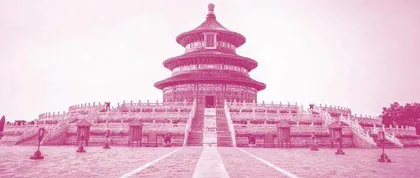The Beijing Central Axis北京中轴线

What comes to your mind when you think of Beijing? The Forbidden City? Tian’anmen Square? The Temple of Heaven?
These famous landmarks are all located along the central axis. It is the best-preserved core area of the old city of Beijing.
The central axis refers to the “line” that separates the eastern and western parts of Beijing. At 7.8 kilometers long, it runs from Yongding Gate in the south to the Bell Tower and Drum Tower in the north. Construction began in the Yuan Dynasty (1271—1368), and continued during the Ming and Qing dynasties.
The central axis is like the backbone of Beijing. It smartly organized the palaces, temples and altars, markets and streets in ancient times.
The central axis shows the traditional Chinese concept of “respecting the center”. This stressed the importance of imperial power, as the royal palace would be in the central spot. Other important buildings were placed around it. For example, the Imperial Ancestral Temple was to the east of the Forbidden City, while the Altar of Land and Grain lay to the west.
提起北京,你会想到什么?故宫、天安门广场,还是天坛?
这些著名的地标建筑均位于北京的中轴线上。北京中轴线上的建筑是古代北京城市保存最完好的核心区域。
北京中轴线是一条分割北京东西部的“线”。此线长7.8千米,南起永定门,北至钟鼓楼,始于元代(1271—1368),在明清两代得以延伸。
中轴线就像北京的脊梁,巧妙地串联了古代的宫殿、寺庙、祭坛、市场和街道。
北京中轴线体现了中国传统的“尚中”观念,将皇宫置于中心位置,其他重要建筑安置在四周,从而强调皇权的重要性。例如,太庙在故宫东面,而社稷坛在其西面。
The central axis also shows traditional Chinese ideas like harmony between man and nature and following order. It runs from the south to the north, the same as the direction of a meridian. The ritual culture that started from the Zhou Dynasty (11th century BC—256 BC) stressed balance, symmetry and order. There are lots of symmetric buildings along the axis. The Forbidden City is the most well-known.
Beijing was not the first city to use a central axis. During the Three Kingdoms Period (220—280), the city Yecheng had a street running from the east to the west. It separated the royal palaces from common people’s living and business areas. In Chang’an (now in Shaanxi Province), the capital of the Tang Dynasty (618—907), there was a wide street from the north to the south. It made the city symmetrical.
“The central axis is more than a material relic. It is also a continuation of the traditional Chinese city layout concept,” said Shan Jixiang, former director of the Palace Museum.
北京中轴线还体现了中国传统思想,如天人合一、和谐共生、井然有序。中轴线自南向北延伸,与子午线的方向相同。这种始于周朝(前11世纪—前256年)的礼乐文化注重平衡、对称和秩序,因而沿轴线排布有很多对称的建筑,其中故宫最为著名。
北京并不是第一个使用中轴线的城市。三国时期(220—280),邺城有一条自东向西的街道,将皇家宫殿与平民的生活区和商业区分隔开。唐朝(618—907)的都城长安(位于今陕西省),有一条从北至南的宽阔街道,将城市对称分割。
故宫博物院前院长单霁翔说:“中轴线不是简单的物质遗存,而是中国传统都城规划观念的不断延续。”
Word Bank
axis /'æksɪs/ n. (复数axes) 轴;坐标轴
core /kɔː(r)/ adj. 最重要的;核心的
backbone /'bækbəʊn/ n. 脊柱;支柱
meridian /mə'rɪdiən/ n. 子午线;经线
symmetry /'sɪmətri/ n. 对称
relic /'relɪk/ n. 遗迹;遗俗